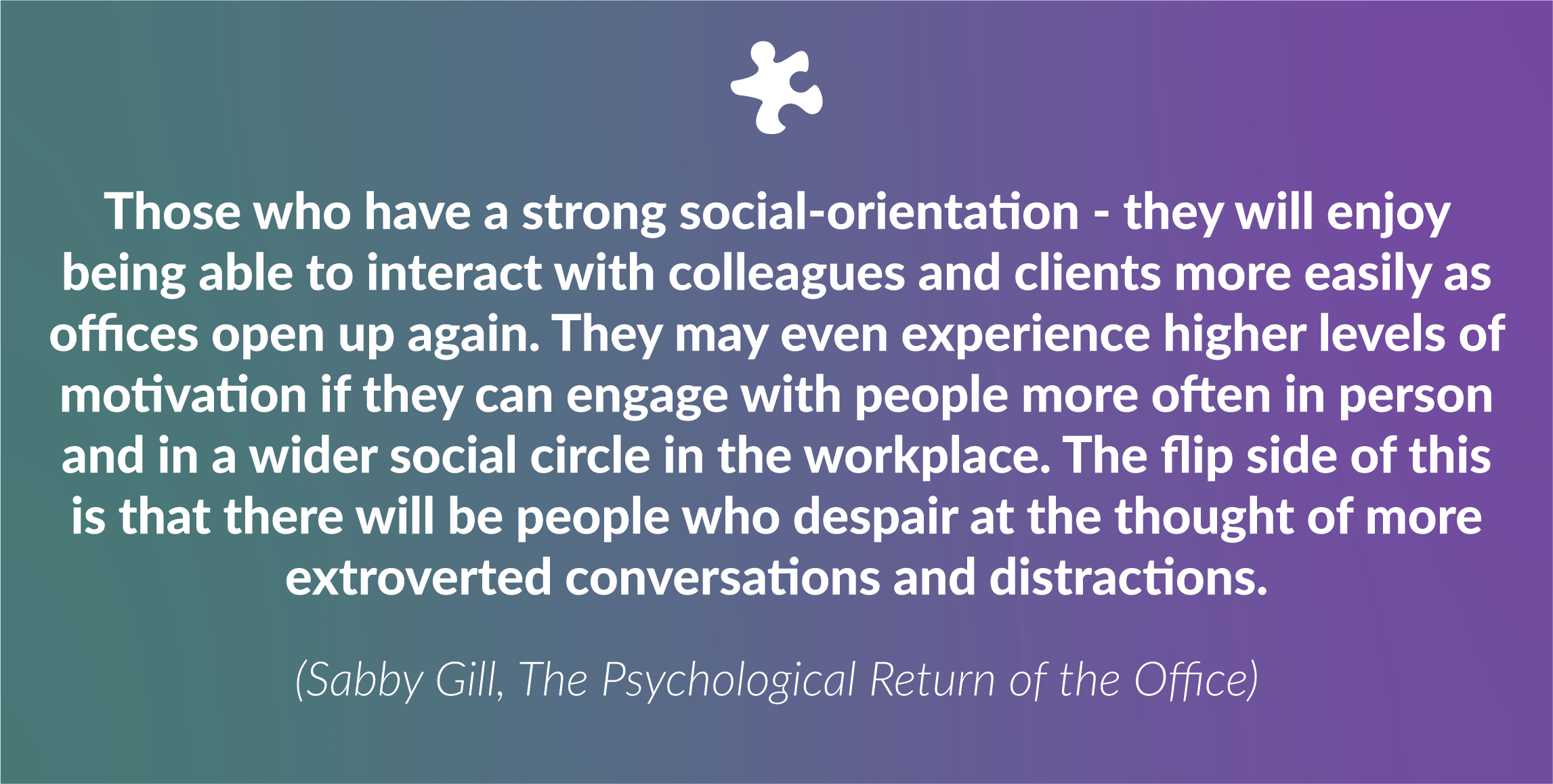Hybrid working practices are fast becoming the norm for companies of all types around the world. While many consider remote working to be positive, or even a workplace benefit, it is something that is also viewed with some degree of scepticism by others. Some individuals thrive in a fully remote working environment, whilst others seem to struggle to stay motivated. Then there are those who like to have a bit of both, going into the office once or twice a week, working remotely the rest of the time. The challenge now is for managers to manage these hybrid teams and their return to work.
Understanding individual differences can help managers:
- Keep their team engaged
- Understand the optimal hybrid working combination to keep employees focused
- Pre-empt stress management and adaptability in individuals when they return to work
So how does emotional intelligence help with this challenge?
Learning about our own personalities and emotional intelligence is a great way to better understand how we approach work, adaptability, stress management and self-motivation. Previous analyses revealed that employees’ different levels of emotional intelligence caused them to be naturally more or less dispositioned to feel engaged at work. So, since people are engaged differently at work, we should take this into account whether the workforce is working from home, by exploring the challenges some may have to staying engaged in a home office, or returning to the office, some for the first time in over a year, and how best to support them.
The Emotional Intelligence assessment measures how someone understands and manages their own emotions, as well as how they understand and manage other people’s emotions (Petrides, 2009). There are no right or wrong scores, both high and low scorers on the traits have both positive and negative aspects.
TEIQue measures (Petrides, 2009):
Different levels and facets of emotional intelligence will create differing reactions and challenges among employees navigating the new way of working. But there are ways to best manage them so that they remain engaged and motivated.
Low happiness
Research has shown that with a lack of face-to-face interaction, employees might feel that their managers don’t understand their needs from a distance, resulting in lower productivity and fewer supportive behaviours (Golden, 2006). Transitioning to work from home, individuals with lower scores in Happiness may be feeling less content and cheerful with life at the moment as well as more worried about the current situation. At the same time, they may also feel their mood is a reasonable response to the difficulties of returning to the office for the first time, potentially in 18 months. Viewing life in a less upbeat way can allow individuals to perceive worst case scenarios and avoid them.
What to do?
-
Advise low scorers not to worry about things they cannot control
-
Highlight good things that are happening
-
Understand what makes them feel happy
-
Ensure they do things that make them happy in their own environment
-
Encourage opportunities to work in the office or in a collaborative manner, regularly.
Low optimism
Generally, individuals with Low Optimism may struggle to see the positives of a new working environment.
What to do?
-
Talk through what makes you feel optimistic about hybrid working
-
Talk about the opportunity a flexible working environment brings them
-
Team them up with people that have high optimism - remotely and in person (if possible).
Low self-esteem
Individuals with low scores will set high – and potentially unachievable – standards for themselves, and when unable to reach them, they can be very harsh on themselves. Without their teammates there with them, as some may be working remotely, there will be some projects they cannot complete or cannot complete to the high standards they have for themselves. This might create feelings of stress and disappointment. They may also be feeling uncertain about the return to the office after so long, but rather than slowly adjusting, they will rush in.
What to do?
-
Give them time to think a project through
-
Tell them it’s ok to say ‘no’ to new tasks occasionally
-
Identify opportunities to break larger tasks apart into small wins – to make the employee still feel successful and like they are making progress
Low stress management
Employees with low Stress Management scores will feel a lot of stress easily. If returning to work in an office after a period of working remotely, there will be stressors around sharing their working space with others after working alone for so long, be easily distracted by having people around them suddenly, particularly if they lived on their own. It can be as simple as having a sudden change in routine, having to commute for example, that can cause more stress for someone with low stress management.
What to do?
-
If returning to the office, allow them to customise their set up at work to mirror how they work at home
-
Institute an easing in period, don't make them return to work full time immediately
-
Ensure you don’t pass on stress to your employees

High empathy
These individuals feel other people’s emotions, appreciate other people's feelings and are able to take their views into account. This will be difficult in the current environment as they will be hyper-aware of others’ stress and worries, making it more challenging for them to focus on managing their own emotions and well-being.
What to do?
-
Encourage them to take care of their own emotions and well-being
-
Schedule time for them to be away from the desk for rest, exercise and socialising
High relationships
Individuals with high scores in Relationships like to invest time and energy in maintaining positive relationships. Such relationships ensure that they have a circle of people on whom they can rely for a variety of things including: information, social enjoyment and emotional support in difficult circumstances.
What to do?
-
Regular check-ins
-
Virtual team meetings through video calls
-
Ensure they are allocating time to non-work tasks, including time to check up on friends
-
If the hybrid model has been adopted, arrange certain "team days" where the whole team is in the office once a week, or there are informal monthly "team virtual drinks" on a Friday afternoon.
Low adaptability
A general aversion to change is to be expected in individuals like this, who may take more time and need more support to adapt to a new way of working. Any sudden change in routine will be hard to cope with, but one caused by a global pandemic, working from home and then returning to the office, is likely to cause an extreme reaction, even in the most adaptable of individuals.
What to do?
-
Encourage employees to replicate their work routine when working remotely and in the office
-
Show them that the change creates positive opportunities to give them confidence
-
Provide more detail about what changes are occurring, and make sure to take notice of ther preferred communication style when doing so.
Low self-motivation
In a hybrid working environment, when no immediate reward or satisfaction from sharing a job well done is available, or even without the constant presence of a managerial figure, these individuals can struggle to find the motivation to get work done, which can cause procrastination and lack in productivity.
What to do?
-
When your employee finishes a task or achieves a goal, encourage them to reward themselves
-
Encourage them to work with others
-
Explain to them that companionship and support can be motivating as well as provide opportunities for socialising and sharing ideas
-
Set up weekly team meetings where the team is encouraged to share their wins from the previous week and what they are working on this week
Want to learn more? Watch our webinar on demand,"The secret to leading a hybrid workforce: Habits to manage, motivate and engage".
References:
- Barsade, S. G. (2002). The ripple effect: Emotional contagion and its influence on group behavior. Administrative science quarterly, 47(4), 644-675.
- Bartel, C. A., Wrzesniewski, A., & Wiesenfeld, B. M. (2012). Knowing where you stand: Physical isolation, perceived respect, and organizational identification among virtual employees. Organization Science, 23(3), 743-757.
- Golden, T. D. (2006). The role of relationships in understanding telecommuter satisfaction. Journal of Organizational Behavior: The International Journal of Industrial, Occupational and Organizational Psychology and Behavior, 27(3), 319-340.
- Goleman, D., Boyatzis, R. E., & McKee, A. (2001). Primal Leadership: The Hidden Driver of Great Performance. Retrieved from https://hbr.org/2001/12/primal-leadership-the-hidden-driver-of-great-performance.
- Kossek, E. E., Lautsch, B. A., & Eaton, S. C. (2006). Telecommuting, control, and boundary management: Correlates of policy use and practice, job control, and work–family effectiveness. Journal of Vocational Behavior, 68(2), 347-367.
- MacRae, I., & Sawatzky, R. (2020, February 25). What makes a high-potential remote worker? Retrieved from https://www.hrmagazine.co.uk/article-details/what-makes-a-high-potential-remote-worker
- Petrides, K. V. (2009). Psychometric properties of the trait emotional intelligence questionnaire (TEIQue). In Assessing emotional intelligence (pp. 85-101). Springer, Boston, MA.




